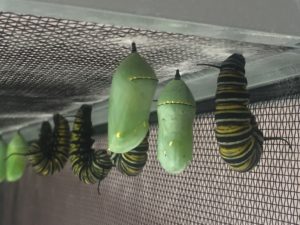 You may have heard the story about a child who insisted on throwing a starfish back into the ocean – one of thousands that got washed ashore alive. When questioned what difference can one starfish out of thousands make, she replied, “It makes a difference to that one!”
You may have heard the story about a child who insisted on throwing a starfish back into the ocean – one of thousands that got washed ashore alive. When questioned what difference can one starfish out of thousands make, she replied, “It makes a difference to that one!”
On our travels this week we had the neat experience of having lunch at a couple’s house that help to hatch butterflies and then release them into the world! Roy and Sherry Clements are very knowledgeable on the subject, and they don’t do it for money. They are simply concerned about the decreasing populations of butterflies, and do something to make a difference.
One of the ways they do this is to adorn around their home with colorful butterfly-friendly plants. Did you know that while butterflies can eat from many of the flowers, each kind of butterfly needs a very specific kind of plant to lay their eggs on? For example, the beautiful Monarch is paired only with the Milkweed plant family. And get this … The tiny creature has the amazing ability to smell their plant from up to a mile away! Unfortunately the rapidly decreasing Monarch population is connected to the decreasing amount of Milkweed plants. I found this to be insightful into something in my personal life.
Another way that Roy and Sherry help the butterflies is to facilitate their transformation in a safe environment. Now it just so happened that as we were saying our final goodbyes to our hosts and heading out the door that we noticed one of them in a cage shedding their final skin! This part happens quite quickly and I captured only the last part of it on video below. The black part on top that was pushed up and then fell to the ground was the outer skin – the part that we visually once knew as a caterpillar. Underneath that outer form is the green chrysalis that protects the magical transformation that will then take place. Basically at this stage the old inside organs break down and the new “butterfly cells” begin to overtake the old. In fact there is very little of the old that is in the new, apart from the basic elements. Does this give you hope? I believe this is an amazing creature that has built into it a glimpse into our own design, as those created in God’s image.
The one other fascinating thing I learned is that butterflies go through several changes where they hang upside down and shed their outer skin. They have to do this or they will die, because the skin gets too tight for their growth. It is the final shedding that begins their metamorphosis into being a butterfly. I know I can relate to having various sheddings in my life, of old ways of thinking and following Jesus. Some of those changes were quite dramatic. (Some of them, such as the swallowtail butterfly, actually change colors each time it goes through its stages!). It’s the final shedding that is the most dramatic, but of course necessary.
This is also interesting – in those several life stages where they shed their skins, their feet are attached to the surface. It’s as if they still “have their feet to the ground” in the world so to speak. But in the final stage they release themselves totally, and spin a silk pad to attach to instead.
The very short video below, although I caught only the latter part of the final skin shedding, shows a rare White Monarch caterpillar wiggling around detaching and making that part to hang by. With the feet now released from the world and inside its protected place, the caterpillar now “dies” to make a place for becoming a butterfly.
The caterpillar and butterfly story is definitely bigger than I know, and bigger than can be handled in this post. Looking up the word ‘metamorphosis’ can yield more amazing insights if you’d like to learn more. It was a privilege meeting Roy and Sherry, two people who are helping to preserve the benefit, the beauty, and the message that the butterflies give to us, and to the preceding generations to come.